Themes > Features
30.04.2002
The Continuing Paradox of World Manufacturing Employment
The issue of the
international relocation of manufacturing production is one which has
received and continues to attract a great deal of attention from not
just economists but policy makers, trade unions and other analysts
across the world. There is a general sense that the past decade in
particular has seen a significant shift in the structure of
international manufacturing production, which is captured in the fact
that developing countries now account for nearly a quarter of world
manufacturing goods exports, up from just over one-tenth two decades
ago.
Such relocation, which in turn is generally supposed to imply a net loss of manufacturing jobs in the North and a net expansion of such jobs in the South, has been seen as being driven by both by the movement of capital, as multinational companies in particular move to areas characterised by cheaper labour, and by trade liberalisation which has allowed manufactured goods produced in Southern locations to penetrate Northern markets. It is recognised that both of these processes have been greatly facilitated by technological change which has allowed for the locational breakup of the productive process and the separation of various elements of it with differing types of skill requirement. This has enabled as "the vertical disintegration of production", with the associated geographical separation of different parts of the production process and increase in intra-industry trade.
It is sometimes argued that this has been accompanied by a process in which manufacturing itself has become less important, both in world production and world trade, as various services activities play more significant roles. However, as Chart 1 shows, during the 1990s, manufacturing exports grew at reasonable rates throughout the 1990s for most important categories of goods, and for some, such as office and telecom equipment, export growth was very rapid indeed.

Of course, within this, the shift in location of manufacturing production from developed to developing countries can be exaggerated. As Chart 2b indicates, even in 2000, certain developed countries dominated world trade in manufactured goods. Indeed, the United States, the European Union and Japan together still accounted for more than 60 per cent of manufactured exports in 2000. But what is evident is that the share of the major developed country exporters had come down even over the decade of the 1990s, continuing a process that had begun earlier and was clearly evident in the 1980s.
Thus, as is clear from a comparison of Charts 2a and 2b, the share of Germany in world manufacturing exports fell quite sharply from 16 per cent to 10 per cent over the decade, and most other major developed country exporters experienced declines in their shares of at least one percentage point or more. Only the United States increased its share, from 12 to 14 per cent, contrary to the widely held perception that it dominated world manufactured goods trade only by virtue of its huge capacity for manufactured imports. In contrast to this, countries like the Peop0le's Republic of China and Mexico managed to nearly triple their shares (albeit from relatively low bases) over this period.

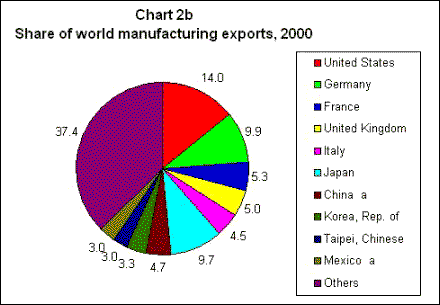
These trends are confirmed by the rates of growth of manufacturing exports of the major exporters, as shown in Chart 3. Among the major developed industrial countries, the US experienced by far the fastest rate of manufactured export expansion. However, a number of developing countries showed dramatically high rates of export growth of nearly 20 per cent annual average over the decade. It should be noted that this cover the period from 1990 to 2000, and so includes periods like the East Asian crisis and the subsequent world economic recession, during which such export growth could be expected to have slowed down somewhat.

With such rapid rates of manufacturing export growth, fears of de-industrialisation would appear to be misplaced. In any case, such high rates would suggest that employment in manufacturing would also have grown at reasonably high, or at least positive, rates, over this period. However, the UNIDO data on aggregate employment in manufacturing over the period 1985-99, as described for some countries in Chart 4, suggest a very different tendency. In fact, it turns out that in most of the countries, aggregate manufacturing employment has actually fallen, in some cases quite substantially.

Among major developed countries, only the United States shows a positive rate of employment growth for aggregate manufacturing, and that too only the very low rate of 0.1 per cent per annum, which is akin to stagnation. Other developed countries show declines in manufacturing employment. But the real shock comes with the developing countries which are major manufactured exporters. Some countries like Mexico, with manufactured exports growing at nearly 20 per cent per annum, have nevertheless experienced actual declines in aggregate manufacturing employment. (The data for Brazil relate to the period 1990-95 only.)
In the Mexican case this is probably because the increase in maquila d'ora export-oriented employment has been outweighed by the collapse in manufacturing production for the domestic market, which has been adversely hit by imports. In other countries of Latin America as well, reasonably high rates of export growth have been accompanied by absolute declines in manufacturing employment. To some extent trade liberalisation, and the associated import penetration of domestic markets, may explain such patterns in these countries also.
But even the "tiger" economies of East and Southeast Asia, with very high rates of export growth, indicate rates of manufacturing employment expansion which are not all that high. For some of these countries, it is possible that the financial crisis of 1997-98 and the subsequent depression may have played a role in subdued employment growth. However, it has been noted that post-crisis rates of export expansion have necessarily been very high in this region, as the crisis-ridden countries have struggled to generate current account surpluses to counter the sudden capital outflows, and generally succeeded in this. This in turn makes it likely that export employment at least would not have slackened very much given the drive to increase exports to earn suddenly scarce foreign exchange.
But certainly it remains true that even in Asia, the effect of trade liberalisation in opening up domestic markets and causing employment to fall in industries catering to the domestic market, should not be underestimated. It should not be forgotten or unnoticed that one of the countries that achieved a respectable rate of increase in aggregate manufacturing employment over this period was China, where such employment increased by 4 per cent per annum. China was in fact one of the few countries in which import liberalisation was relatively limited over the decade, and much of the economy remained highly controlled.
In addition, the state sector in China continued to account for a very substantial share of manufacturing employment, and this was largely protected over the decade. This meant that any increase in export-oriented employment would translate into net additions to jobs, unlike other countries in the region where they would merely counter the effect of job losses in industries catering to the domestic market. It is unlikely that this momentum can be sustained after the entry of China into the WTO, and the rate of net job creation is therefore likely to decelerate.
The other country exhibiting very high rates of growth of manufacturing employment over this period was Malaysia. Once again, the role of the state has been substantial in ensuring and protecting employment through various means in this economy, even though most of the manufacturing employment is in the private sector.
One of the main areas in which developing countries are widely perceived to have comparative advantage in trade is in textiles and clothing. This is why the Uruguay Round Agreement on Textiles and Clothing was seen as a major concession to developing countries, and encouraged them to accept other less palatable aspects of the overall GATT agreements signed at the time. Of course, this particular agreement was back-loaded in terms of relegating most of the required liberalisation to the end of the period.
Meanwhile, in this period during which the Multi-Fibre Agreement was to be phased out, developed countries were allowed a series of "transitional measures" which effectively meant increased protectionism in this sector. Problems of worsened conditions of market access have dominated developing country complaints in this regard. Nevertheless, as can be noted from Chart 1, aggregate textile exports over the decade of the 1990s increase at an annual rate of 4 per cent, and that of clothing at 6 per cent, and it is likely that most of these increases went to developing country exporters.
But consider what has happened, in this context, to employment in this sector in the major developing country exporters, as displayed in Chart 5. Many developing countries – especially those in Latin America and among the more developed in the East Asian region – have actually experienced absolute declines in employment in textiles and clothing. Where the rate of increase in employment in the garments sector has been very high – as for example in Thailand and Indonesia – it has been from a very low base. Overall, the data do not give the impression any significant shift in terms of shift in employment in the textiles and clothing sector.
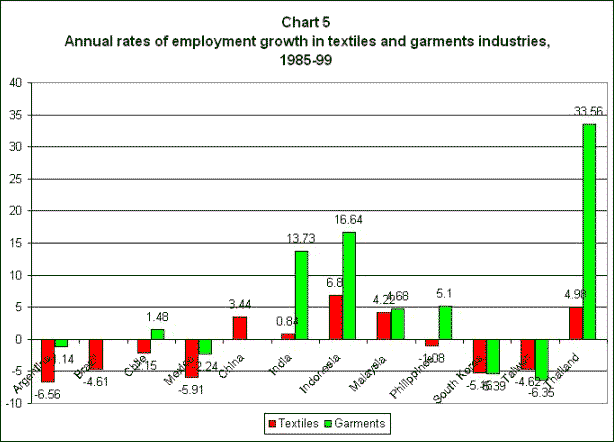
Leather goods and footwear is the other area of traditional manufactured exports of developing countries, and even in this sector, as is clear from Chart 6, employment generation has been less than impressive for the major developing country exporters. Once again, the two countries showing very high rates of employment expansion – Indonesia and Thailand – had very low bases in 1985.

Of course, the real point about relocative manufacturing production is that it is not supposed to be confined to areas of traditional exports of developing countries, but to extend into those areas which were typically seen as the preserve of developed industrial nations. In fact, much of the export success of the more dynamic developing countries of this period was related to their association with the "sunrise" industries, such as the electronics and computer/IT hardware related sectors.
These can be broadly captured in the UNIDO dataset in the categories "electrical machinery" and "scientific and professional equipment". Charts 7 and 8 show the pattern of employment and productivity in the electrical machinery sector for some major developing and developed country exporters, respectively. This yields some surprising results. To begin with, while rates of employment growth in this sector vary across countries, it is true that some Asian countries show very high rates, as expected given their focus on these exports and their increasing shares of the world market in this sector.
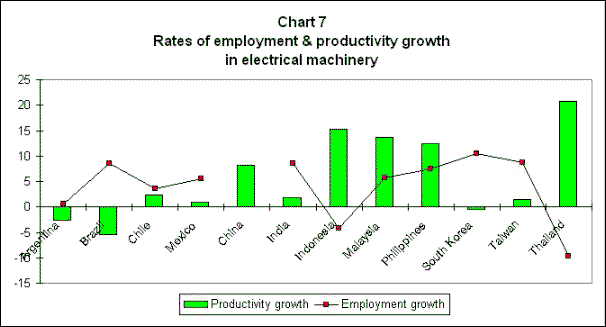
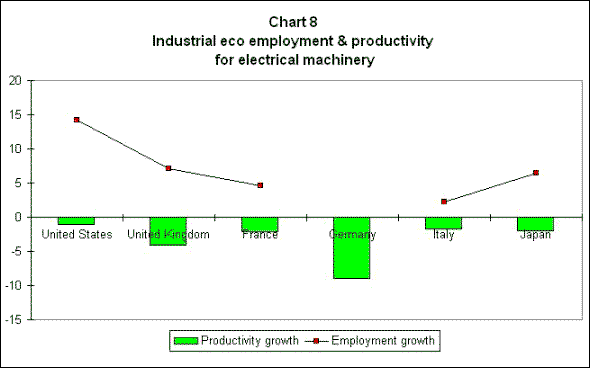
However, rates of productivity growth (defined here as rate of change in value added per employee in constant price terms) appear to be almost inversely related to employment expansion. This needs to be understood more closely. An inverse relation between employment and productivity is quite common in many sectors, especially in primary production, and is even to be expected. However, where increasing returns are thought to prevail (and especially where dynamic returns, as exemplified in Verdoorn's Law which posits a positive relation between rates of output growth and productivity growth) a positive relation would be more expected. These particular manufacturing sectors – electrical machinery, etc. - are generally thought to be characterised by strong increasing returns to scale, especially in the dynamic sense. Therefore this apparent (although clearly not uniform) inverse relation is of some interest.
An exactly similar pattern prevails in developed industrial countries for this sector (Chart 8), suggesting that this is not a pattern specific to developing country producers in this sector. Charts 9 and 10 suggest that similar inferences can be made also for the category of "scientific and professional equipment" production in developing and developed countries.
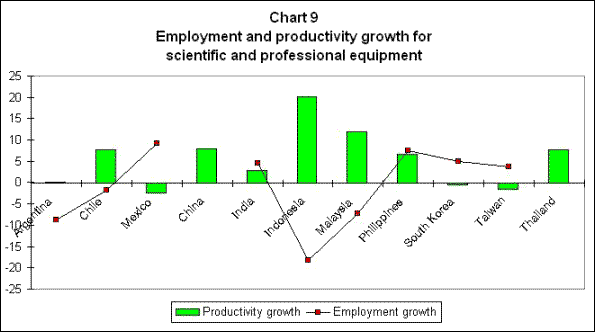
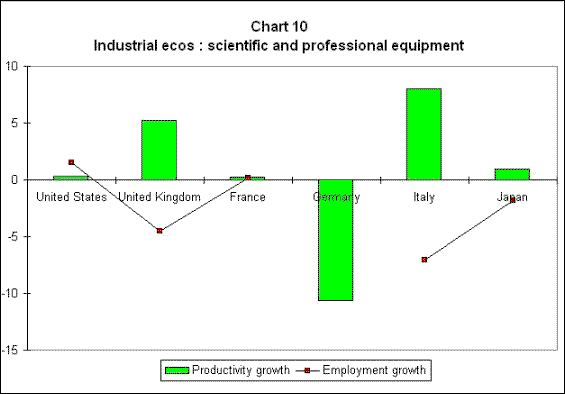
What all this implies is that these sectors – at least over the period under question – were not characterised by dynamic increasing returns in the sense that is usually meant, and that there was therefore a clear trade-off between employment growth and productivity growth. Insofar as there was high employment growth in some countries in these broad sectors, it reflected lower rates of labour-saving technological change as much as demand-led expansion.
The other major categories in which developing country manufactured exports have grown significantly and in which developing countries as a whole have increased their shares of world markets, are plastic products and fabricated metal products. Charts 11 and 12 show employment and productivity growth for major developing country exporters. Once again, the inverse relation appears to operate, barring some spectacular outliers such as Thailand in the case of fabricated metal products (in which the high rates of employment and productivity growth are both upon low bases).


What is especially notable is that in all of these supposedly dynamic developing country export sectors, only a handful of countries - and that too, mainly confined to the East/Southeast Asian region – showed very high rates of employment expansion over this period. These were Malaysia, Indonesia, Philippines, and most of all China. Indeed, because China shows relatively high rates of growth of employment, all of which reflect the already huge base of manufacturing employment, it alone accounts for the vast bulk of job creation among all developing countries over this period. And, as we have already mentioned, this very large increase in turn was associated with the fact of import regulation and state control for China's domestic manufacturing sector over most of this period.
In sum, the evidence on developing country manufacturing employment, even in the sectors supposedly associated with the highest rates of export expansion and industrial relocation, suggests that net increases in employment generation have been concentrated in very few countries. Most developing countries have actually experienced stagnation or even declines in aggregate manufacturing employment.
This in turn reflects technological changes which lead to greater use of labour-saving methods of production which are expressed in high rates of productivity growth in some countries. And this may result from the greater competitive pressures, which have come about simply because of the combination of increased concentration of production and need to generate higher export revenues across all developing countries.
Such relocation, which in turn is generally supposed to imply a net loss of manufacturing jobs in the North and a net expansion of such jobs in the South, has been seen as being driven by both by the movement of capital, as multinational companies in particular move to areas characterised by cheaper labour, and by trade liberalisation which has allowed manufactured goods produced in Southern locations to penetrate Northern markets. It is recognised that both of these processes have been greatly facilitated by technological change which has allowed for the locational breakup of the productive process and the separation of various elements of it with differing types of skill requirement. This has enabled as "the vertical disintegration of production", with the associated geographical separation of different parts of the production process and increase in intra-industry trade.
It is sometimes argued that this has been accompanied by a process in which manufacturing itself has become less important, both in world production and world trade, as various services activities play more significant roles. However, as Chart 1 shows, during the 1990s, manufacturing exports grew at reasonable rates throughout the 1990s for most important categories of goods, and for some, such as office and telecom equipment, export growth was very rapid indeed.

Of course, within this, the shift in location of manufacturing production from developed to developing countries can be exaggerated. As Chart 2b indicates, even in 2000, certain developed countries dominated world trade in manufactured goods. Indeed, the United States, the European Union and Japan together still accounted for more than 60 per cent of manufactured exports in 2000. But what is evident is that the share of the major developed country exporters had come down even over the decade of the 1990s, continuing a process that had begun earlier and was clearly evident in the 1980s.
Thus, as is clear from a comparison of Charts 2a and 2b, the share of Germany in world manufacturing exports fell quite sharply from 16 per cent to 10 per cent over the decade, and most other major developed country exporters experienced declines in their shares of at least one percentage point or more. Only the United States increased its share, from 12 to 14 per cent, contrary to the widely held perception that it dominated world manufactured goods trade only by virtue of its huge capacity for manufactured imports. In contrast to this, countries like the Peop0le's Republic of China and Mexico managed to nearly triple their shares (albeit from relatively low bases) over this period.


These trends are confirmed by the rates of growth of manufacturing exports of the major exporters, as shown in Chart 3. Among the major developed industrial countries, the US experienced by far the fastest rate of manufactured export expansion. However, a number of developing countries showed dramatically high rates of export growth of nearly 20 per cent annual average over the decade. It should be noted that this cover the period from 1990 to 2000, and so includes periods like the East Asian crisis and the subsequent world economic recession, during which such export growth could be expected to have slowed down somewhat.

With such rapid rates of manufacturing export growth, fears of de-industrialisation would appear to be misplaced. In any case, such high rates would suggest that employment in manufacturing would also have grown at reasonably high, or at least positive, rates, over this period. However, the UNIDO data on aggregate employment in manufacturing over the period 1985-99, as described for some countries in Chart 4, suggest a very different tendency. In fact, it turns out that in most of the countries, aggregate manufacturing employment has actually fallen, in some cases quite substantially.

Among major developed countries, only the United States shows a positive rate of employment growth for aggregate manufacturing, and that too only the very low rate of 0.1 per cent per annum, which is akin to stagnation. Other developed countries show declines in manufacturing employment. But the real shock comes with the developing countries which are major manufactured exporters. Some countries like Mexico, with manufactured exports growing at nearly 20 per cent per annum, have nevertheless experienced actual declines in aggregate manufacturing employment. (The data for Brazil relate to the period 1990-95 only.)
In the Mexican case this is probably because the increase in maquila d'ora export-oriented employment has been outweighed by the collapse in manufacturing production for the domestic market, which has been adversely hit by imports. In other countries of Latin America as well, reasonably high rates of export growth have been accompanied by absolute declines in manufacturing employment. To some extent trade liberalisation, and the associated import penetration of domestic markets, may explain such patterns in these countries also.
But even the "tiger" economies of East and Southeast Asia, with very high rates of export growth, indicate rates of manufacturing employment expansion which are not all that high. For some of these countries, it is possible that the financial crisis of 1997-98 and the subsequent depression may have played a role in subdued employment growth. However, it has been noted that post-crisis rates of export expansion have necessarily been very high in this region, as the crisis-ridden countries have struggled to generate current account surpluses to counter the sudden capital outflows, and generally succeeded in this. This in turn makes it likely that export employment at least would not have slackened very much given the drive to increase exports to earn suddenly scarce foreign exchange.
But certainly it remains true that even in Asia, the effect of trade liberalisation in opening up domestic markets and causing employment to fall in industries catering to the domestic market, should not be underestimated. It should not be forgotten or unnoticed that one of the countries that achieved a respectable rate of increase in aggregate manufacturing employment over this period was China, where such employment increased by 4 per cent per annum. China was in fact one of the few countries in which import liberalisation was relatively limited over the decade, and much of the economy remained highly controlled.
In addition, the state sector in China continued to account for a very substantial share of manufacturing employment, and this was largely protected over the decade. This meant that any increase in export-oriented employment would translate into net additions to jobs, unlike other countries in the region where they would merely counter the effect of job losses in industries catering to the domestic market. It is unlikely that this momentum can be sustained after the entry of China into the WTO, and the rate of net job creation is therefore likely to decelerate.
The other country exhibiting very high rates of growth of manufacturing employment over this period was Malaysia. Once again, the role of the state has been substantial in ensuring and protecting employment through various means in this economy, even though most of the manufacturing employment is in the private sector.
One of the main areas in which developing countries are widely perceived to have comparative advantage in trade is in textiles and clothing. This is why the Uruguay Round Agreement on Textiles and Clothing was seen as a major concession to developing countries, and encouraged them to accept other less palatable aspects of the overall GATT agreements signed at the time. Of course, this particular agreement was back-loaded in terms of relegating most of the required liberalisation to the end of the period.
Meanwhile, in this period during which the Multi-Fibre Agreement was to be phased out, developed countries were allowed a series of "transitional measures" which effectively meant increased protectionism in this sector. Problems of worsened conditions of market access have dominated developing country complaints in this regard. Nevertheless, as can be noted from Chart 1, aggregate textile exports over the decade of the 1990s increase at an annual rate of 4 per cent, and that of clothing at 6 per cent, and it is likely that most of these increases went to developing country exporters.
But consider what has happened, in this context, to employment in this sector in the major developing country exporters, as displayed in Chart 5. Many developing countries – especially those in Latin America and among the more developed in the East Asian region – have actually experienced absolute declines in employment in textiles and clothing. Where the rate of increase in employment in the garments sector has been very high – as for example in Thailand and Indonesia – it has been from a very low base. Overall, the data do not give the impression any significant shift in terms of shift in employment in the textiles and clothing sector.

Leather goods and footwear is the other area of traditional manufactured exports of developing countries, and even in this sector, as is clear from Chart 6, employment generation has been less than impressive for the major developing country exporters. Once again, the two countries showing very high rates of employment expansion – Indonesia and Thailand – had very low bases in 1985.

Of course, the real point about relocative manufacturing production is that it is not supposed to be confined to areas of traditional exports of developing countries, but to extend into those areas which were typically seen as the preserve of developed industrial nations. In fact, much of the export success of the more dynamic developing countries of this period was related to their association with the "sunrise" industries, such as the electronics and computer/IT hardware related sectors.
These can be broadly captured in the UNIDO dataset in the categories "electrical machinery" and "scientific and professional equipment". Charts 7 and 8 show the pattern of employment and productivity in the electrical machinery sector for some major developing and developed country exporters, respectively. This yields some surprising results. To begin with, while rates of employment growth in this sector vary across countries, it is true that some Asian countries show very high rates, as expected given their focus on these exports and their increasing shares of the world market in this sector.


However, rates of productivity growth (defined here as rate of change in value added per employee in constant price terms) appear to be almost inversely related to employment expansion. This needs to be understood more closely. An inverse relation between employment and productivity is quite common in many sectors, especially in primary production, and is even to be expected. However, where increasing returns are thought to prevail (and especially where dynamic returns, as exemplified in Verdoorn's Law which posits a positive relation between rates of output growth and productivity growth) a positive relation would be more expected. These particular manufacturing sectors – electrical machinery, etc. - are generally thought to be characterised by strong increasing returns to scale, especially in the dynamic sense. Therefore this apparent (although clearly not uniform) inverse relation is of some interest.
An exactly similar pattern prevails in developed industrial countries for this sector (Chart 8), suggesting that this is not a pattern specific to developing country producers in this sector. Charts 9 and 10 suggest that similar inferences can be made also for the category of "scientific and professional equipment" production in developing and developed countries.


What all this implies is that these sectors – at least over the period under question – were not characterised by dynamic increasing returns in the sense that is usually meant, and that there was therefore a clear trade-off between employment growth and productivity growth. Insofar as there was high employment growth in some countries in these broad sectors, it reflected lower rates of labour-saving technological change as much as demand-led expansion.
The other major categories in which developing country manufactured exports have grown significantly and in which developing countries as a whole have increased their shares of world markets, are plastic products and fabricated metal products. Charts 11 and 12 show employment and productivity growth for major developing country exporters. Once again, the inverse relation appears to operate, barring some spectacular outliers such as Thailand in the case of fabricated metal products (in which the high rates of employment and productivity growth are both upon low bases).


What is especially notable is that in all of these supposedly dynamic developing country export sectors, only a handful of countries - and that too, mainly confined to the East/Southeast Asian region – showed very high rates of employment expansion over this period. These were Malaysia, Indonesia, Philippines, and most of all China. Indeed, because China shows relatively high rates of growth of employment, all of which reflect the already huge base of manufacturing employment, it alone accounts for the vast bulk of job creation among all developing countries over this period. And, as we have already mentioned, this very large increase in turn was associated with the fact of import regulation and state control for China's domestic manufacturing sector over most of this period.
In sum, the evidence on developing country manufacturing employment, even in the sectors supposedly associated with the highest rates of export expansion and industrial relocation, suggests that net increases in employment generation have been concentrated in very few countries. Most developing countries have actually experienced stagnation or even declines in aggregate manufacturing employment.
This in turn reflects technological changes which lead to greater use of labour-saving methods of production which are expressed in high rates of productivity growth in some countries. And this may result from the greater competitive pressures, which have come about simply because of the combination of increased concentration of production and need to generate higher export revenues across all developing countries.
© MACROSCAN 2002